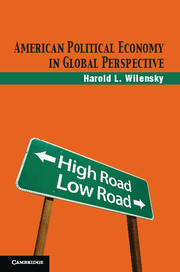Book contents
- Frontmatter
- Contents
- Figures
- Tables
- Preface and Introduction
- Acknowledgments
- Part I Globalization, Public Policy, and the Well-Being of People
- 1 The Welfare State as the Center of Public Finance and Political Conflict
- 2 Energy Policy and Performance
- 3 What Trade-Offs Are Good and Bad for the Economy?
- 4 Retrenchment of the Welfare State?
- 5 Pensions Converge, U.S. Health Care Remains Unique
- 6 The Impact of “Globalization”
- Part II Moving the United States Off the Low Road
- Appendix
- Notes
- Bibliography
- Index
2 - Energy Policy and Performance
The United States and the World
Published online by Cambridge University Press: 05 June 2012
- Frontmatter
- Contents
- Figures
- Tables
- Preface and Introduction
- Acknowledgments
- Part I Globalization, Public Policy, and the Well-Being of People
- 1 The Welfare State as the Center of Public Finance and Political Conflict
- 2 Energy Policy and Performance
- 3 What Trade-Offs Are Good and Bad for the Economy?
- 4 Retrenchment of the Welfare State?
- 5 Pensions Converge, U.S. Health Care Remains Unique
- 6 The Impact of “Globalization”
- Part II Moving the United States Off the Low Road
- Appendix
- Notes
- Bibliography
- Index
Summary
I am involved in mankind and therefore never send to know for whom the bell tolls; it tolls for thee.
John Donne (1624)To report the current consensus of climate scientists is to risk sounding alarmist. Only 25 or so years ago a substantial minority of serious scientists doubted that emissions of heat-trapping gases by human activity would lead to irreversible global warming. But not all alarms are false. And successive research reports by such agencies as the National Academy of Sciences, the National Oceanic and Atmospheric Administration, the U.S. Geological Survey, the International Energy Agency, NASA’s Goddard Institute for Space Studies, and the UN’s Intergovernmental Panel on Climate Change have grown more urgent about an approaching tipping point. For instance, there is now agreement that when and if the atmospheric concentration of carbon dioxide – the principal heat-trapping gas emission – reaches 450 to 600 parts per million, up from about 385 ppm today, irreversible planetary damage will occur. Before the summer of 2007 scientists underestimated the speed with which warming temperatures would melt the polar regions’ permafrost that caps large deposits of methane, another potent greenhouse gas. So if we add methane emissions, the new tipping point may be even less than 450 ppm of CO2. Because of the way CO2 persists in the atmosphere and in the oceans and the interaction of the two, the result will include rising seas that threaten coastal regions. Southern Europe, North Africa, the Southwestern United States, and West Australia could expect 10 percent less rainfall. That means reduced crop yields and fiercer storms alternating with Dust Bowl levels of drought (Solomon et al., 2009; Hansen et al., 2008). Too little discussed is a tsunami of climate refugees numbering perhaps one or two hundred million pouring into nations and regions on higher ground searching for water, food, shelter, and safety. Such migration would make the current flow from Mexico into the United States look like a trickle.
- Type
- Chapter
- Information
- American Political Economy in Global Perspective , pp. 15 - 41Publisher: Cambridge University PressPrint publication year: 2012
- 1
- Cited by



